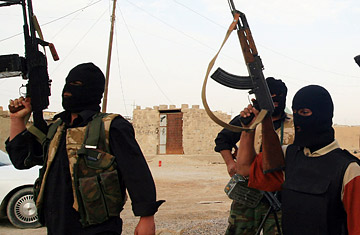
Iraqi Shiite fighters wave their weapons as they celebrate an end to clashes with Iraqi government troops in the southern city of Basra.
During the appearance of General David Petraeus and Ambassador Ryan Crocker before lawmakers this week, one major aspect of the picture in Iraq got scant mention. Iraq's Sunni insurgency and its most vicious wing, al-Qaeda in Iraq, was hardly discussed, even though Petraeus stressed that the Sunni insurgency remained alive and a potent threat. Anyone tuning in to C-SPAN — including al-Qaeda — might have gleaned a few lessons from the testimony about the U.S. strategy and vulnerabilities in Iraq.
Lesson One: The Americans don't have as tight a hold on the government of Nouri al-Mailiki as one might think. Many Iraqis hostile to the government take Maliki to be little more than an American stooge. But Petraeus revealed to lawmakers that Maliki went against his advice in launching an attack against the Mahdi Army in Basra, where Maliki's forces were quickly bogged down and bloodied by Sadr's street fighters. That means the Americans may not have the ability to stop the Iraqi government from an even worse strategic blunder in a place where Sunni insurgents might deal a blow, like Diyala Province or Mosul.
Lesson Two: You can rattle the Americans and the Iraqi government considerably by attacking the Green Zone. Blasts in the enclave where the Iraqi government and the American command stay had fallen off steeply until the most recent wave of fighting. In recent months people inside the Green Zone felt safer and maybe a little bolder — possibly one reason for picking a fight in Basra. But a steady hail of rockets falling on and around Iraqi government buildings suddenly got Maliki talking about a political compromise with Sadr, at least for a time. In other words, the "heavily fortified" Green Zone is looking more like a soft spot.
Lesson Three: A good time for the insurgents to renew their bloody acts in Baghdad would be mid-August, when Petraeus and other American commanders will come to the end of what he called a 45-day "period of consolidation and evaluation" following the departure of the last surge troops in July. Hardcore jihadists like the fighters of al-Qaeda in Iraq want American forces to stay, not go. They enjoy the opportunity to confront them with guerrilla warfare and care little about what that does to Iraq. They want the fight to go on. Al-Qaeda in Iraq has in the past shown deftness in timing gruesome attacks to maximize public attention in the hopes of shaping political decisions. A sudden string of insurgent attacks around August would likely leave Petraeus and decision makers in the Bush White House reluctant to withdraw more troops.
Lesson Four: Al Qaeda may seize the opportunity to make dramatic gestures. The Sunni insurgency has genuinely been put back on its heels in the face of the surge, and there may be a temptation among insurgent strategists to lie low and regroup in their remaining havens around Iraq. But any insurgent pause now may mean lost chances to attack American troops and to score political points just as the disposition of U.S. military strength is up for debate.
